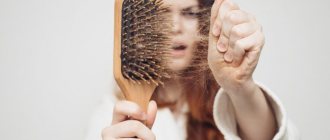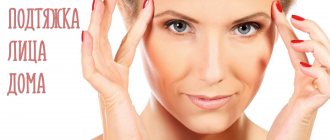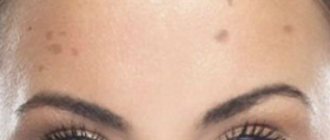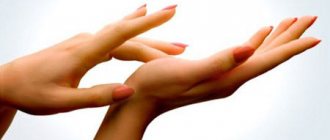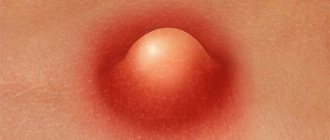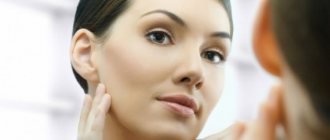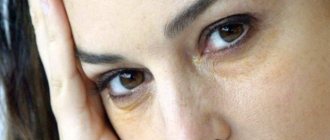- March 17, 2019
- Hair treatment
- Yana Yakovenko
Alopecia is pathological hair loss. This condition differs from male pattern baldness due to the uneven hair loss. Characterized by complete or partial loss of hair in certain areas of the head. Compared to male pattern baldness, it is less common, but it is a fairly serious problem. At an advanced stage, alopecia in women can cause complete hair loss.
The problem occurs in 30% of the fairer sex. These are women aged 25 to 45 years. However, it has been noted that alopecia is often diagnosed after 40. In men, baldness is much more common, but not all of them respond to this problem, while for women, hair loss is a real disaster at any age.
Reasons for appearance
They are numerous, so it is extremely important to see a doctor and get tested so that he can create a complete picture of the condition of your body. There are also completely harmless causes of alopecia in women - frequent drinking of alcohol and large doses of caffeine and nicotine. If you give up these bad habits, the situation will normalize.
Also, the causes of alopecia in women are as follows:
- Development of scalp fungus. It causes the appearance of alopecia areata.
- Lack of zinc and other important micro- and macroelements. In this case, there is also a deterioration in the condition of the skin and nails.
- Pregnancy, breastfeeding period. In this case, the nutrients entering the body are almost completely absorbed by the fetus. Hormonal changes also occur, which negatively affects the skin and nails. The woman also constantly suffers from fatigue. All this together can cause alopecia.
- Thyroid diseases. Since it produces hormones that affect the functioning of our entire body, disruption of its functionality leads to numerous symptoms. This may be alopecia, cracks in the skin, drowsiness, “waves” on the nails.
- Frequent stress and nervous system disorders. Due to deterioration of blood circulation in the vessels of the brain, the follicles receive less nutrition, which is why hair begins to fall out.
- Iron deficiency anemia. Lack of hemoglobin is often a consequence of excessive physical exertion and amenorrhea. It often occurs among lovers of “proper” nutrition, who sometimes do not receive enough micro- and macroelements from food.
- Any chronic disease worsens the condition of the hair over time. This could be intoxication of the body, rheumatoid arthritis, lupus erythematosus, infections such as syphilis and tuberculosis.
- Polycystic ovary syndrome. In this case, the body experiences a lack of estrogen and an excess of testosterone, which has an extremely negative effect on the condition of the hair. Also, an excess of testosterone is observed with pituitary hyperplasia, proliferation of the adrenal cortex, and taking steroid drugs.
- Some medications that need to be taken for a long time. These are hormonal contraceptives, laxatives, antidepressants, anabolic steroids, drugs for weight loss and cancer. Aspirin can also be included in this list.
- Frequent cosmetic procedures. Dyeing, blow-drying, perming and other procedures have an extremely negative impact on the health of the hair. With regular thermal and chemical damage, hair begins to fall out very quickly.
- Hypothermia of the scalp, resulting in vasospasm.
- Radiation therapy, burns.
- Alopecia can also be hereditary, but this is quite rare. Often occurs in children. In this case, atrophy of hair follicles is observed in all areas of the scalp. Also, this condition is often accompanied by other pathologies. A characteristic feature of hereditary alopecia is its presence in several family members.
Diseases that provoke autoimmune alopecia
Partial or complete hair loss can be caused by the development of the following diseases:
- Graves' disease is a pathological process in the body caused by severe disruption of the thyroid gland. The main symptoms of the disease are bulging, enlarged eyes, swollen eyelids, a constant feeling of anxiety and headache, disruption of metabolic processes and the balance of hormones in the body. Excess thyroid hormones cause severe complications of the nervous system, heart and liver.
- Rheumatoid arthritis is an autoimmune disease in which the human immune system ceases to distinguish foreign microorganisms from its own cells. Falling under the aggressive influence of the immune system, the joints become inflamed and gradually destroyed. The first signs of this pathological process are: severe pain that occurs when moving, a feeling of stiffness, swelling and redness of the joint. The severe consequences of rheumatoid arthritis are heart and respiratory diseases, muscle atrophy, nail deformation, and thinning of the skin.
- Diabetes mellitus is a disease of the endocrine system caused by a lack of the hormone insulin. Diabetes mellitus is characterized by metabolic disorders in the body and damage to the blood vessels of the circulatory system. The patient suffers from a constant feeling of thirst, excessive dry skin, and cramps. Insufficient attention to the treatment of this disease can cause severe damage to the retina, veins, and peripheral nerves.
- Lupus erythematosus is an autoimmune disease caused by a disorder of the immune system in which the DNA of healthy cells is damaged at the molecular level. A characteristic symptom of the disease is numerous redness and rashes of the skin, which merge together to form a butterfly shape. Lupus erythematosus affects the heart and vascular system, kidney tissue.
Attention! It is impossible to eliminate the problem of autoimmune alopecia if the underlying disease is not cured. Only with timely diagnosis and quality treatment can the rate of hair loss be slowed down.
Stages and their symptoms
Each hair goes through three stages in its development - active growth (2-4 years), an intermediate phase when it stops growing, but the cells of the hair papilla in the follicle are still functioning (15-20 days), and complete cessation of growth (1-3 months ), when the old hair eventually falls out, pushed out by the new one. 93% of hair on the human body is constantly in the growth phase, 1% is in the resting phase and 6% is preparing to fall out. The growth cycle is repeated approximately 25 times.
Experts say that losing up to 100 hairs per day is normal. If violated, a woman begins to lose up to 1000 hairs. It is this intense hair loss that can lead to baldness.
Signs of alopecia in women depend on the stage. There are only three of them. The disease begins with thinning hair in the parting area.
- At the first stage, thinning is observed near the forehead and in the parietal area.
- The second is characterized by moderate hair loss.
- At the third stage, noticeable thinning of the hair on the crown occurs. The hair remains at the temples, but it is much sparser and thinner than it was before.
Types of alopecia in women
There are 3 types of alopecia. Let's look at each of them in more detail.
Alopecia areata in women is rare, as reported by statistics. However, in practice, doctors often diagnose this particular type of baldness. The disease occurs suddenly. Hair begins to fall out locally, forming round or oval patches of bare skin. The lesions can be multiple, but often there is only one. In areas of hair loss, the skin turns red, itching and burning appear, and at first you can see holes left in the place of the fallen follicles.
There are several types of alopecia areata in women:
- subtotal;
- with one hearth;
- with numerous foci;
- total;
- nesting
At the last stage, hair falls out all over the body. In parallel, the disease also affects the nails. It often occurs due to hereditary predisposition under the influence of associated factors.
Androgenetic alopecia in women is a congenital pathology. It often begins to appear during hormonal changes in the body. It is characterized by a wave-like course: at first the hair falls out very quickly, then this process stops - and everything repeats again.
A characteristic symptom is rapid greasy hair. In place of those that fall out, new ones grow, but thinner and almost colorless. In women, androgenic type alopecia appears by the age of 30 and is characterized by uniform hair loss in the parting area.
Scarring alopecia occurs as a result of trauma to the scalp. Individual pockets of bare skin with traces of damage appear. Nearby there are areas of skin with broken or even completely intact hair.
Diffuse alopecia is also called symptomatic. Often the moment when intense hair loss began is easy to trace. The process can begin after severe stress, pregnancy, poisoning, taking medications, or diet. Hair falls out intensively and evenly throughout the head. At the same time, in the crown area, the outline of bare skin resembles the letter I. Baldness is also observed in the area of the frontal part and temples.
Types of disease
There are several types of alopecia in women. Treatment is selected individually, depending on the type of disease. Each of them has its own characteristics, different causes and forms of manifestation.
The first type of alopecia in women is focal. Treatment of this form begins with eliminating the root cause, which is the inflammatory process in the body, stress, and head injury. This type of baldness is characterized by the formation of a bald spot, a rounded bald spot. Due to its appearance, the disease is also called alopecia areata in women. Treatment helps stop the growth of bald spots and restore hair growth.
The second type of baldness develops solely against the background of hormonal imbalance. It's called androgenetic alopecia. Treatment in women involves reducing the concentration of hormones in the body - androgens, which cause male pattern hair loss.
It is most difficult to find the cause of the third form of the disease. Before starting treatment for diffuse alopecia in women, which is manifested by uniform thinning of hair over the entire surface of the head, the patient will have to undergo a serious examination. One of the common causes of diffuse hair loss is seborrhea.
Importance of diagnosis
It is extremely important to determine the causes of baldness. Otherwise, treating symptoms will not stop the process completely. If your hair is thinning intensively for several weeks in a row, this is a reason to consult a trichologist. He will prescribe the necessary studies. What tests do women undergo for alopecia?
In case of baldness in women, the trichologist first of all sends the patient for examination to a gynecologist and endocrinologist. Men are immediately referred to a gastroenterologist or neurologist. Patients are recommended to have an ultrasound of the thyroid gland and undergo a general and biochemical blood test. The latter will show whether the kidneys, liver, and pancreas are functioning normally. You definitely need to get tested for thyroid hormones. The following indicators are important: TSH, T3 and T4, FSH, LH, prolactin, progesterone, free testosterone, DHEA-S (a hormone produced by the adrenal glands).
Alopecia in women - what to do and how to treat?
Statistics report that every third woman in the world will one day face the problem of hair loss. After eliminating certain factors, such as seasonality or hair loss due to diet, the problem resolves on its own. Other reasons require additional assistance to the body.
Unfortunately, our hair acts as a kind of indicator that signals diseases of internal organs that have not yet made themselves felt. Many ladies try to restore their hair using cosmetic procedures. If your hair loss is caused by coloring or frequent use of a hair dryer, this may help.
Alopecia due to thermal and chemical effects - treatment
To restore volume and thickness to your hair, you should pay attention to medicinal cosmetics and traditional medicine. In particular, they can help:
- shampoos;
- masks;
- vegetable oils.
It should be noted that vegetable oils are considered very effective in the fight against alopecia. Indian women (who often have voluminous, shiny hair) widely use oils for scalp massage, for example, bhringaraj, brahmi, and amla herbal oil. Or at least coconut oil, even in its pure form. Olive, burdock, almond or grape seed oil are also suitable. However, such procedures quickly wash off the dye, and it is also very difficult to wash your hair after using them.
Essential oils are even more effective. In 1998, a study was conducted in Scotland in which subjects used a special oil composition. It included the following components: ethers of thyme, cedar, lavender, rosemary, as well as base oils of grape seed and jojoba. As a result, scientists determined that half of the subjects showed improvements.
How to cure alopecia in women, which is caused by exposure to chemicals? It is recommended to use masks made from natural ingredients. They need to be applied half an hour before washing your hair. Making such a mask is very simple at home. It may contain egg yolk, red pepper, sour cream, kefir, mustard and other components.
What does traditional medicine offer?
Is it possible to treat baldness at home, and what products should be used for this? This question often worries those who have had to experience the full severity of this disease. Of course, you can fight baldness at home, but it is important to do it correctly and resort to methods approved by your doctor.
Treatment of alopecia with folk remedies involves the use of herbal decoctions, ointments, ampoules, masks, and sprays. Procedures such as massage and darsonvalization are also indicated.
Folk remedies against alopecia are easy to prepare at home. All components for ointments, masks and infusions can be purchased at pharmacies and grocery stores.
Aloe
You can add aloe to hair masks
The therapeutic effect is achieved only when using a plant that is at least 3 years old. You need to make lotions from aloe juice on the affected areas on the head. After a napkin soaked in juice is applied to the head, it must be wrapped in film. You need to wash it off after half an hour. This procedure should be carried out at least twice a day.
Decoction of birch buds
Pour 1 tbsp. l. raw materials 1 liter of water and boil it for about half an hour. Then the liquid must be allowed to cool and then strain. Use as a rinse after every hair wash.
Garlic and onion mask
Garlic has a beneficial effect on hair
Grind these products into a paste and strain through cheesecloth to obtain juice. Rub the liquid into the affected areas of the scalp several times a week.
Red hot pepper tincture
It is important to remember the contraindications for using pepper spray.
This product helps strengthen hair follicles and prevent hair loss. Hot pepper tincture can be purchased at a pharmacy or prepared at home. The liquid is rubbed into the hair roots in its pure form or added to homemade masks. The tincture must be used with extreme caution, as there is a risk of burning the scalp or causing severe allergies. If after applying it an unbearable burning sensation occurs, you must wash it off immediately.
Shampoos for alopecia
How to cure alopecia in women using shampoo? A doctor will help you choose a product, since you need to take into account the composition and characteristics of the scalp when buying shampoo. The “correct” product should not contain Sodium Laureth Sulfate, Sodium Lauryl Sulfate. It should also contain vitamins and minerals - copper, zinc, B vitamins, plant extracts and components that stimulate blood circulation (onions, coffee, red pepper).
We provide you with a list of the most effective means:
- Shampoo “Onion 911”, produced by JSC “Twins Tech”. Prevents hair loss and stimulates hair growth. The composition is almost completely natural. But it should be used for a long time to achieve the desired effect.
- Fitoval from KRKA works very quickly, the result is noticeable after 4-5 procedures. Suitable for oily hair.
- “Hair Power” from Biocon is an economical and effective option, but can cause an allergic reaction.
- “Horsepower” is saturated with useful components, makes hair harder and thicker, and prevents hair loss. However, it contains sodium laureth sulfate and is not suitable for dry hair. Although women who have tried it on themselves speak very positively about it.
Vitamins and hair loss
This photo shows products that contain the components necessary for hair growth.
How to cure alopecia in women caused by a lack of vitamins and minerals in the body? We provide you with a rating of the best vitamin complexes.
- Solgar Skin, Nails and Hair. The expensive American complex (about 1,700 rubles for 60 tablets) is a very effective remedy for hair loss in women. In addition, it also improves the condition of nails and skin. It is considered the best complex for vegetarians.
- Nature's Bounty is the best product with B vitamins. Its price is up to 2000 rubles. Does not contain dyes or preservatives.
- “Fitoval” costs up to 400 rubles. The active ingredients are yeast, iron, zinc, folic acid, cystine and other beneficial substances. Strengthens hair and stimulates its growth. Allowed for pregnant women.
- "Perfectil Plu" is a complex from an English manufacturer. Its composition includes ascorbic acid, silicon, iodine, iron, biotin, folic acid, burdock extracts, echinacea, etc. Women note rapid hair growth, shine and strengthening of nails, evening out skin tone and radiance. The drug also helps against hair loss. It has a positive effect on the scalp and protects it from negative influences.
Vitamins for alopecia in women are applicable only at the beginning of the hair loss process. At later stages, such therapy is no longer effective.
Cure possibilities
As you can see, in this case, it will not be possible to manage only with traditional methods and even ultra-modern drugs against hair loss. But they shouldn’t be discounted either - in war, all means are good. They will give excellent results as part of a comprehensive treatment and will speed up the growth of new hairs, if at all possible.
In the treatment of autoimmune diseases, the professionalism of the doctor and a comprehensive individual approach to treatment are especially important.
With focal alopecia, when hair falls out in clearly defined areas, the likelihood of it stopping and complete hair restoration is higher than with total baldness. But you can’t give up in any case!
Drug therapy
Based on the results of the examination, the doctor will definitely prescribe a course of drug therapy. It will most likely include:
- corticosteroids in the form of ointments or subcutaneous injections to relieve active inflammatory processes;
- retinols – drugs that restore the scalp;
- minoxidil is an effective remedy against hair loss;
- cytostatics - drugs that reduce the activity of the immune system;
- zinc – for strengthening and growth of new hair;
- local irritants – to awaken “sleeping” hair follicles and activate blood circulation in the scalp;
- multivitamin complexes (high in group B) – activator of new hair growth.
Tar ointment, decoctions and tinctures of herbs, and homemade hair masks with natural vegetable and/or essential oils may also be recommended.
Treatment of androgenetic alopecia
Androgenetic alopecia is caused by an excess of male sex hormones in a woman’s body.
For this type of baldness, the drug Minoxidil is effective. This is a well-known hair drug that has a vasodilating effect. It ensures an active supply of oxygen and nutrients to the hair follicles, normalizes metabolic processes, activating hair growth. Hair becomes stronger and hair loss stops.
However, the remedy for hair loss in women and men, Minoxidil, must be taken for at least six months to achieve the desired effect. Also, patients sometimes note a side effect in the form of facial hair growth. However, this medicine for alopecia in women is one of the most popular.
Also, some consider the use of phytoestrogens to be effective. They are found in oats, beer, and lentils. You can also find dietary supplements containing phytoestrogens on sale.
Methods and rules of treatment
If your hair is noticeably thinning, consult a trichologist: a specialist deals with problems of the scalp. In the early stages of baldness, it is easier to achieve treatment results.
The doctor will prescribe tests to determine what led to the weakening of the hair follicles and loss of hair shafts. In many cases, treating the underlying condition stops hair loss.
Do not self-medicate: improper therapy will worsen the condition of your hair. Only comprehensive treatment will relieve alopecia.
READ ALSO: Thinning hair or baldness in men: causes and treatment with folk remedies and medications
Pay attention to modern procedures. For diffuse, focal, androgenic, seborrheic forms of hair loss, mesotherapy is effective - microinjections of special solutions. The composition of meso cocktails includes: proteins, vitamins, medicinal molecules, amino acids, plant extracts, panthenol, salicylates, hyaluronic acid.
Look at the original options for a ladder haircut for medium hair.
Read about the causes and treatment of eyelash loss on this page.
Basic rules for patients:
- strictly follow the treatment regimen: insufficient course duration or interruption of treatment will reduce the results. Buy prescribed ointments, creams, tablets, lotions. Ask your trichologist how to replace expensive medications if you lack finances. Trichological drugs have many budget analogues;
- get ready for long-term use of medications, local treatment of lesions: for some forms of alopecia, treatment and maintenance therapy last more than one year;
- change your diet, include more healthy foods. For health and hair strength, cereals, legumes, and dairy products are indispensable. Load up on vegetables, fruits, leafy greens, and sea fish. Bran, flax seeds, eggs, nuts, vegetable oils are useful;
- normalize your routine, worry less, sleep at least 7 hours, spend more time in the fresh air. Lack of sleep and stress reduce the effectiveness of therapy;
- select medicated shampoos for hair loss, supplement your care with special balms, lotions, and masks. Products against hair thinning and for hair growth from the brands Vichy, Fitoval, Evalar, Granny Agafya's Recipes, Aleran, Selentsin have earned a lot of positive reviews;
- refuse to dye with synthetic components, use varnish, mousse, foam, and use heat styling devices less often;
- regularly make masks from natural ingredients, rinse weakened strands with herbal infusions, apply hair wraps, aroma combing, rub in healing tinctures;
- deal with your hormonal levels. An endocrinologist will examine you and find out your hormone levels. If any violations are detected, undergo a course of treatment. For certain diseases, constant use of medications is necessary to maintain sufficient levels of hormones;
- If noticeable hair loss begins after childbirth, be sure to consult a gynecologist. Find out which anti-alopecia medications are harmless for your baby (if breastfeeding).
Drug therapy
The choice of medications has characteristics for each form of baldness. Some drugs have a universal effect and are suitable for the treatment of various types of alopecia.
Listen to the recommendations of trichologists:
- therapy for the androgenetic form consists of blocking receptors sensitive to the action of the male hormone dihydrotestosterone (the “culprit” of alopecia). The use of phytoestrogens reduces the side effects of taking potent medications. Compositions that regulate the production of hormones improve the condition of the hair in case of hormonal disorders;
- for nervous tension and increased fatigue, sedatives and immunomodulators are recommended. For depression, attend psychotherapy sessions;
- insufficient hormone levels require treatment by an endocrinologist. Hormonal therapy is selected on an individual basis; the duration of the course and the treatment regimen will be advised by the doctor;
- if hair thinning is caused by fungal or bacterial infections, use antifungal, anti-inflammatory drugs for local treatment. Which ointment or cream to choose? The doctor will tell you. Fluconazole, Miconazole, Acyclovir, Ketoconazole, Terbizine, Syntomycin emulsion are effective. For advanced cases, antibiotics are needed.
Note! Lotions, sprays, and gels for topical use containing the medicinal molecules Aminexil and Minoxidil give good results. Some drugs are not cheap, but regular application of the compositions gives good results.
Find out the nuances of hair extensions for very short hair.
Look at this address for hairstyle options for little girls.
Follow the link to read more about shampoos for hair lamination.
Vitamin preparations
If the hair follicles are not properly nourished, the doctor will prescribe vitamins and nutritional supplements with active substances. For strong, healthy curls, B vitamins, tocopherol, retinol, ascorbic acid, brewer's yeast, minerals, and proteins are needed.
READ ALSO: Effective folk remedies for hair loss in women at home: recipes for all hair types and preventive measures
Popular vitamins for hair loss:
- Esvicin.
- Pantovigar.
- Perfect.
- Merz special dragee.
- Revalid.
- Evalar Hair Expert.
- Vitamins Fitoval.
- Zincteral.
- Inneov Hair density.
- Selentsin dietary supplement.
- Dietary supplements with brewer's yeast;
- Pyridoxine.
Ampoules for hair growth
How to cure alopecia in women at home with their help? Ampoules are sold in pharmacies and beauty supply stores. Each ampoule contains a number of microelements that eliminate hair loss and stimulate hair growth. They need to be used daily for 2-3 months.
After washing your hair, distribute the ampoule evenly throughout your hair and lightly massage your scalp. This will accelerate microcirculation and allow the composition of the ampoules to begin to act faster.
Procedures in a cosmetology salon
In addition to medications, various cosmetic and physiotherapeutic procedures have been recognized as effective for the treatment of alopecia in women. Their implementation aims to enhance blood microcirculation and activate hair growth in the “dormant” hair follicles. The most effective types of treatment are:
- Mesotherapy – medical procedures mean a course of injections into the scalp. Preparations for mesotherapy are selected individually. Their action is aimed at restoring follicles and providing nutrition to the epidermis.
- Cryotherapy - involves the use of liquid nitrogen and head massage. The main goal of cryotherapy sessions is to stop the process of hair loss and improve local blood circulation.
- Darsonvalization is the effect of weak currents on the epidermis of the head. During treatment procedures, oxygen is enriched, the production of sebaceous glands is reduced, blood vessels dilate, and lymph outflow improves.
- Laser therapy is the most expensive and effective way to treat alopecia in women. Thanks to the effect of the laser beam, hair shafts thicken, impaired metabolic processes and microcirculation in tissues are restored.
Hair transplantation
Today, there are several types of hair transplant surgeries for women.
- The strip method is quite painful and leaves scars and marks. At the same time, the hair density in the transplant area is far from natural and is about 40 hairs per cm2.
- FUE-machine is also an invasive, but more painless technique. Repeated transplantation is impossible, but the density of hair in the transplantation area leaves much to be desired.
- HFE (upgraded FUE-hand) is the most popular technique. It is seamless and virtually painless. Transplantation is also carried out using a microsurgical implanter, which pierces the skin and immediately implants the follicle. The recovery period after surgery is minimal. Hair density is 80 hairs per cm2.
